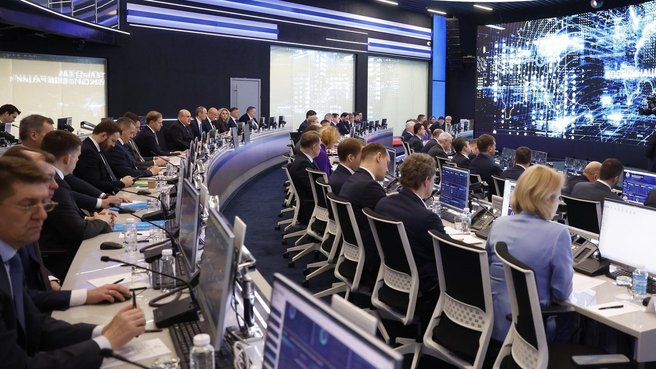Mikhail Mishustin: “We need to focus our efforts on achieving several priority objectives, particularly on reducing the economic and social security divide between the Russian regions. To address this, we need to establish relevant growth centres in each region that would draw on the region’s capacity in agriculture, industry, or logistics, to ensure the influx of investment and an increase in jobs.”
Mikhail Mishustin’s opening remarks:
Good afternoon, colleagues.
Today we will have an extensive discussion
on the new concept of the Spatial Development Strategy. I previously instructed
the Ministry of Economic Development at one of the past strategic sessions to draft
this concept.
In his Address to the Federal Assembly,
the President specifically focused on this important issue. Specifically, he
focused on ensuring connectivity across Russia’s
territory and reducing infrastructure constraints in the regions, including in transport and energy; providing urban amenities and improving
the quality of life in small towns, historical communities and rural areas; and measures to support Russian regions, primarily those located on the country’s
border. These are the Kaliningrad Region, the Far East, the Arctic zone, the North Caucasus, as well as our new regions.
The current Strategy was adopted in 2019,
and it was formulated in a different environment. Therefore, the objectives to be addressed, and the tools to be used for implementing the updated document
should take into account the current geopolitical challenges and regional and municipal priorities. In addition, they should be aligned with the national
projects, which the President discussed at length in his Address, as well as national goals and other programmes that will be updated in the near future.
In the face of external restrictions,
the Government has developed and implemented a range of policies in response to the President’s instructions. These measures have helped support the national economy,
enabling it not only to survive, but also to adapt and continue to advance.
These impressive results have opened up new horizons
for Russia’s
spatial development.
First, in the realm of industry, domestic
manufacturers are now taking over the market niches vacated by foreign
companies. They are boosting production capacity and establishing new
facilities to make their products. New technological chains are being built
within the country and, very importantly, related industries are employed. Furthermore,
cooperation between various regions is intensifying.
New roads and transport facilities are being
developed, paving the way for regional economic growth and entrepreneurial
activity. As this infrastructure continues to expand, it will streamline logistics,
redirect commodity flows, create additional tourist routes, and generally ensure
greater connectivity across the regions.
Moving forward, we need to focus
our efforts on achieving several priority objectives, particularly on reducing
the economic and social security divide between the Russian regions. To address
this, we need to establish relevant growth centres in each region that would
draw on the region’s capacity in agriculture, industry, or logistics, to ensure
the influx of investment and an increase in jobs.
In fact, we have included these four indicators – GRP
growth, investment, new jobs and people’s real incomes in the respective
regions – in the key parameters for the deputy prime ministers’ oversight of the federal districts.
This will help us continue building modern housing,
kindergartens, clinics and hospitals, and modernising utilities, so that
residents of remote areas also have access to high-quality medicine, education,
heating and clean water.
The President emphasised the need for regions to become
more self-sufficient, providing all residents with equal opportunities for fulfilment and high living standards.
To achieve this, it is crucial to increase the level
of regional autonomy and improve state and municipal administration, enabling
effective decision-making to address key challenges.
A clear economic model for our regions’ development, integrated
into territorial planning, connectivity and spatial development strategies, is
essential for guiding our efforts.
Colleagues,
The new Strategy concept is a complex and extensive
document. Our task today is to outline the priorities for the country’s spatial
development over the next decade, taking into account all the risks and opportunities. We must establish clear goals and identify the tools and mechanisms necessary to achieve them.

